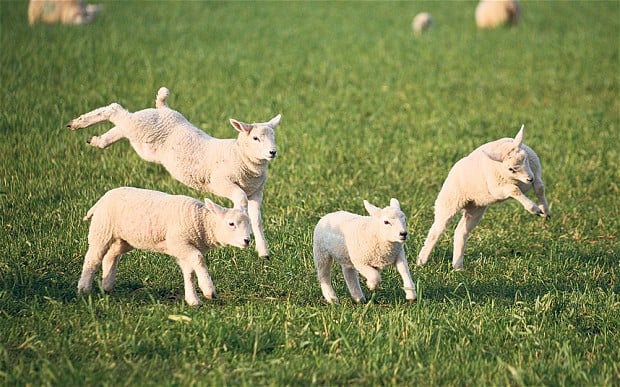June 11th, 2013 by
"Schmallenberg" is the name of a recent virus. It was identified in November 2011 in Germany on several samples taken from cattle and sheep. Similarly to the Sweet Itch virus affecting horses, this virus has been the headlines of numerous newspaper such as The Northern Echo , The Yorkshire Post , the BBC , the SouthWest Farmer and few more...
The Schmallenberg virus is part of the family of Bunyaviridae, more precisely Orthobunyaviridae. This virus is similar to known viruses Akabane, Aino and Shamonda - 3 well known viruses affecting only ruminants - but present very different symptoms.
- In cattle, the virus causes two types of symptoms. In the adult cattle, the virus is represented by relatively general symptoms like fever, loss of appetite, degradation of general health, decrease of dairy production (sometimes up to half of the normal production), even diarrhoea. These symptoms often disappear within few days.
- In calves, the virus results in abortions, still-births and congenital deformations as consequences of infection during gestation.
- In sheep, symptoms are only observed on lambs which were infected during the gestation of the ewe. Abortions, still-births and congenital deformations can be observed.
The Schmallenberg virus is mainly transmitted by midges and mosquitoes. As such the virus is generally spread in late summer, from August to October. According to the recent information, it turns out that the virus of Schmallenberg affects only the ruminants and doesn't present any risks for the human health.
Schmallenberg virus solutions
It's possible to treat animals only once they're affected by the virus. No vaccine has been found yet to fight the Schmallenberg virus. However, it's possible to protect the livestock from the midges and mosquitoes which spread diseases, thus severely reducing infection rates. Prevention is always better than the cure! HSDonline and Agropharm have developed a government approved product specifically to deter flying insects from livestock, its name is Neem Pro Riddance.
Neem Pro Riddance is a health maintenance insect control product derived from Neem plant oil for use against nuisance pests such as biting and egg laying flies and biting midge vector of the Orthobunya virus (Schmallenberg).
HSDonline has been recently featured in the Telegraph national paper in an article dedicated to the Schmallenberg virus where a famous vet, Pete Wedderburn is talking about our preventive treatment while waiting for the vaccine. To get rid of midges, a single application of Neem Pro Riddance is normally sufficient to provide control for up to 10 weeks. The active ingredient doesn't penetrate the animal skin, but dissolves into the skin oils, giving a long term protection. (Note that Neem Pro Riddance is available as a concentrate for dilution and spraying or as a hand spray for spot application, particularly during ear tagging).
What to do in the event of suspected Schmallenberg infection
According to European legislation, no measures are in place yet to fight this disease. However, if a farmer observes symptoms that could be attributed to Schmallenberg infection within his cattle, he must quickly consult a veterinarian. The vet will take some samples in order to send them to laboratories of DGZ and ARSIA to help the Schmallenberg virus research. This examination includes:
- For alive animals: complete blood and serum test, as well as Nasal swab and a sample of diarrhoea
- For the still-born animals: send the complete foetus.
Current state of the Schmallenberg virus in Great Britain and abroad
 In summer 2011, in Germany and the Netherlands, unusual clinical symptoms in dairy cows were noticed for the first time. An increasing number of infected herds was highlighted at the end of October, where the number of cases surprisingly decreased. In December 2011, numerous cases of still-born lambs, (born with twisted neck, deformed limbs...) were also recorded in Holland and in Belgium. Some calves presenting similar symptoms were also spotted. So far, the Schmallenberg virus has already been diagnosed in 14 European countries, including UK. Recent data shows that the Schmallenberg virus is present in Europe, and spreading. In affected areas, it's possible that animals not affected yet by the virus, are still vulnerable and that newborn animals will continue to be observed over the following months. In affected zones, it's fairly possible that animals not having been affected by the virus yet, are still vulnerable and, ultimately, that newborn animals will be observed over the following months in the UK. At the moment, it's really difficult to determine if the Schmallenberg virus has recently been introduced or if it has been present for some time, but only recently noticed. All we know is that scientific searches are progressing well in order to tackle this terrible disease and help thousands of farmers and that a vaccine could be available this summer in UK.
In summer 2011, in Germany and the Netherlands, unusual clinical symptoms in dairy cows were noticed for the first time. An increasing number of infected herds was highlighted at the end of October, where the number of cases surprisingly decreased. In December 2011, numerous cases of still-born lambs, (born with twisted neck, deformed limbs...) were also recorded in Holland and in Belgium. Some calves presenting similar symptoms were also spotted. So far, the Schmallenberg virus has already been diagnosed in 14 European countries, including UK. Recent data shows that the Schmallenberg virus is present in Europe, and spreading. In affected areas, it's possible that animals not affected yet by the virus, are still vulnerable and that newborn animals will continue to be observed over the following months. In affected zones, it's fairly possible that animals not having been affected by the virus yet, are still vulnerable and, ultimately, that newborn animals will be observed over the following months in the UK. At the moment, it's really difficult to determine if the Schmallenberg virus has recently been introduced or if it has been present for some time, but only recently noticed. All we know is that scientific searches are progressing well in order to tackle this terrible disease and help thousands of farmers and that a vaccine could be available this summer in UK.
Comments
Leave a reply
Your e-mail address will not be published. All fields are required




